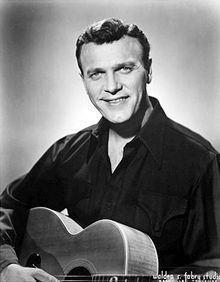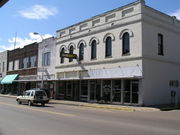Eddy Arnold
| Eddy Arnold | |
|---|---|
 |
|
| Background information | |
| Birth name | Richard Edward Arnold |
| Also known as | The Tennessee Plowboy |
| Born | May 15, 1918 |
| Origin | Henderson, Tennessee, USA |
| Died | May 8, 2008 (aged 89) |
| Genres | country music, gospel music, pop music |
| Occupations | singer, songwriter, TV host, actor |
| Instruments | guitar, banjo |
| Years active | 1937 –2008 |
| Labels | RCA Records (1944–1970s; 1976–2008) MGM Records (1970s–1976) |
| Website | www.eddyarnold.com |
Richard Edward Arnold (May 15, 1918–May 8, 2008), known professionally as Eddy Arnold, was an American country music singer who performed for six decades. He created the Nashville sound in the late 1950s, and had 147 songs on the Billboard country music charts, second only to George Jones. Though Jones had more individual hits, one authoritative study ranks Arnold as the all-time leader for hits and their time on the charts. Arnold sold more than 85 million records from 1943 until his death in 2008.
Arnold transcended different musical tastes in country music. He served as a role model for future musicians with both his music and his scrupulously moral personal life. A member of the Grand Ole Opry (since 1943) and the Country Music Hall of Fame (since 1966), Arnold ranked 22nd on County Music Television's 2003 list of "The 40 Greatest Men of Country Music."
Contents |
Biography
Early years
Arnold was born on May 15, 1918 on a farm near Henderson, Tennessee. His father, a sharecropper, played the fiddle, while his mother played guitar. As a boy Arnold helped on the farm, which later gained him his nickname—the Tennessee Plowboy. Arnold attended Pinson High School in Pinson, Tennessee, where he played guitar at school functions and events. He dropped out before graduation to help with the farm work, but continued performing, often arriving on a mule with his guitar hung on his back. Arnold also worked part time as an assistant at a mortuary.[1]

In 1934, at age 16, Arnold made his debut on WTJS-AM in Jackson, Tennessee, landing a job there in 1937. He performed at local night clubs and had a permanent spot on the station. In 1938, was hired at WMPS-AM in Memphis, Tennessee, where he was one of its most popular performers. He soon left for KWK-AM in St. Louis, Missouri,[2] followed by a brief stint at WHAS-AM in Louisville, Kentucky.
He appeared on WSM-AM on the Grand Ole Opry in 1943 as a solo artist.[1] In 1944, Arnold signed an RCA Records contract, under manager Colonel Tom Parker, who later managed Elvis Presley. Arnold's first single went unnoticed[3], but the followup, "Each Minute Seems a Million Years", reached No. 5 on the country charts in 1945.[1] Its success kicked off a decade of unprecedented chart performance; Arnold's next 57 singles all reached the Top Ten, including 19 number one hits.[4]
In 1946, Arnold scored his first major hit with "That's How Much I Love You". In 1948, he had five hits on the charts simultaneously. That year he had nine songs reach the top 10; five of these reached No. 1 and held the top spot for 40 of the year's 52 weeks. Under Parker's management, Arnold continued to dominate, with 13 of the top 20 country music songs of 1947–1948.[1] He became the host of Mutual Radio's Purina-sponsored segment of the Opry, and of Mutual’s Checkerboard Jamboree, a midday show shared with Ernest Tubb that was broadcast from a Nashville theater.[5] Recorded radio shows widened Arnold’s popularity, as did the CBS Radio series Hometown Reunion with the Duke of Paducah. Arnold left the Opry in 1948, and his Hometown Reunion briefly aired in head-to-head competition with the Opry on Saturday nights. In 1949 and 1950, he appeared in the Columbia films Feudin’ Rhythm and Hoedown.[6]
Arnold moved to television in the early 1950s, hosting The Eddy Arnold Show. The summer program aired on all three television networks, replacing the Perry Como and Dinah Shore shows.[7] He also appeared as a guest and a guest host on the ABC-TV show Ozark Jubilee from 1955–60.[8] Arnold starred in the syndicated Eddy Arnold Time from 1955 to 1957.[9] From 1960 to 1961, he hosted NBC-TV's Today on the Farm.[10]
Second career: the Nashville sound
During the 1950s, the most popular music was rock and roll, which caused a drop in Arnold's record sales, though he and RCA singer Jim Reeves reached a wider audience with pop-sounding string-laced arrangements. In 1955, Arnold upset many in the country music establishment by recording with the Hugo Winterhalter Orchestra in New York. The pop-oriented arrangements of "Cattle Call" and "The Richest Man (in the World)", however, helped to expand his appeal beyond its country base.[11] This sound, created by Reeves and Arnold, became known as the Nashville sound.[11] In 1953, Arnold and Tom Parker had a falling out, and Arnold fired him. From 1954 to 1963, Arnold's performances were managed by Joe Csida; in 1964 Csida was replaced by Jerry Purcell.[12]
Arnold embarked on a second career that brought his music to a more diverse audience. In 1965, he had one of his biggest hits with "Make the World Go Away". With the Anita Kerr Singers as backup and accompanied by pianist Floyd Cramer, Arnold's rendition became an international hit.[11]
Bill Walker's orchestra arrangements provided the lush background for 16 continuous hits sung by Arnold during the later 1960s. Arnold performed with symphony orchestras in New York City, Las Vegas and Hollywood. He performed at Carnegie Hall for two concerts, and at the Coconut Grove in Las Vegas.[11] In 1966, Arnold was inducted into the Country Music Hall of Fame, the youngest performer to receive the honor.[13] The following year Arnold was voted the first-ever awarded Country Music Association's Entertainer Of The Year.[14] Two years later, Arnold released an autobiography named It's A Long Way From Chester County.[15]
Having been with RCA Records since his debut in 1944, Arnold left the label in the mid-1970s for MGM Records, where he recorded four albums, which included several top 40 hits. He returned to RCA Records in 1976.[1]
Later years and death
In the 1980s, Arnold declared himself semi-retired; however, he continued recording. In 1984, the Academy of Country Music awarded Arnold its Pioneer Award. However, he then released no recordings for seven years. He discussed starting again in 1990, but had to undergo heart surgery. His next album was released in 1991 as You Don't Miss A Thing.[1] Arnold performed on the road for several more years.[16] By 1992, he had sold nearly 85 million records, and had a total of 145 weeks of No. 1 songs, more than any other singer.[1]
In 1996, when Arnold was 76, RCA Records released an album of his top hits since 1944 as part of a series on singers.[1] Arnold then retired from active singing, though he still performed occasionally.[11] On May 16, 1999, the day after his 81st birthday, he announced his final retirement during a concert at the Hotel Orleans in Las Vegas.[17] That same year, the National Academy of Recording Arts and Sciences inducted the recording of "Make The World Go Away" into the Grammy Hall of Fame. In 2000, he was awarded the National Medal of Arts.[18] In 2005, Arnold received a lifetime achievement award from the Recording Academy,[19] and later that year, released an album with RCA Records called After All These Years.[20]
Eddy Arnold died of natural causes at 5:00 a.m. CT on May 8, 2008 in a nursing home in Nashville, a week before his 90th birthday. His wife of 66 years, Sally Gayhart Arnold, had preceded him in death by two months. They were survived by two children, two grandchildren, and four great-grandchildren.[21]
On May 31, 2008, RCA Records released as a single "To Life", a song from the album After All These Years. It debuted at No. 49 on the Hot Country Songs charts, Arnold's his first entry in 25 years and a recording by the oldest person to chart in Billboard. It set the record for the longest span between a first chart single and a last: 62 years and 11 months ("Each Minute Seems Like a Million Years" debuted on June 30, 1945), and extended Arnold's career chart history to seven decades.[22]
Eddy Arnold gained many fans throughout his career. They included people as diverse as Ray Charles, Jerry Lee Lewis, Elvis Presley, and Jim Reeves.
Discography
References
- ↑ 1.0 1.1 1.2 1.3 1.4 1.5 1.6 1.7 Stambler, Irwin; Grelun Landon, Lyndon Stambler (2000). Country Music: An Encyclopedia. Macmillan Publishers. pp. 17–19. ISBN 9780312264871. http://books.google.com/books?id=RjfB6-nVHZIC&pg=PA17&dq=Eddy+Arnold&client=firefox-a. Retrieved July 15, 2009.
- ↑ Streissguth, Michael (1997). Eddy Arnold-Pioneer of the Nashville Sound. Shirmir Books. ISBN 0-02-964719-X.
- ↑ http://www.ask.com/music/artist/Eddy-Arnold/1507
- ↑ "Heartaches By the Number", Cantwell, David & Friskics-Warren, Bill, 2003, Vanderbilt University Press, pg. 146
- ↑ Pugh, Ronnie (1998). Ernest Tubb: The Texas Troubadour. Duke University Press. ISBN 9780822321903.
- ↑ Pinkerton, Johnathan (May 15, 2009). "That Nashville Sound pioneering musician Eddy Arnold among celebs born on May 15". Nashville Examiner. http://www.examiner.com/x-5967-Nashville-Entertainment-Examiner~y2009m5d15-That-Nashville-Sound-pioneering-musician-Eddy-Arnold-among-celebs-born-on-May-15. Retrieved July 15, 2009.
- ↑ Brooks, Tim; Marsh, Earle (1992). The Complete Directory to Prime Time Network TV Shows. Ballentine Books. ISBN 0-345-37792-3.
- ↑ Weekly program listings (1955-1960), Triangle Publications TV Guide, Vols. 3-8
- ↑ Streissguth, Michael (1997). Eddy Arnold-Pioneer of the Nashville Sound. Shirmir Books. ISBN 0-02-964719-X.
- ↑ McNeil, Alex (1996). Total Television. Penguin Books. ISBN 0 14 024916 8.
- ↑ 11.0 11.1 11.2 11.3 11.4 Rumble, John (1998). Paul Kingsbury. ed. The Encyclopedia of Country Music. Oxford University Press.
- ↑ Flippo, Chet (May 8, 2008). "NASHVILLE SKYLINE: Remembering Eddy Arnold". Country Music Television. http://www.cmt.com/news/country-music/1587136/nashville-skyline-remembering-eddy-arnold.jhtml. Retrieved July 15, 2009.
- ↑ Press, Associated (May 8, 2008). "Country legend Eddy Arnold dies". MSNBC. http://www.wickedlocal.com/norwich/entertainment/music/x647002031/Country-star-Eddy-Arnold-dies. Retrieved July 15, 2009.
- ↑ "CMA Awards Ceremonies". Country Music Association. 2009. http://www.cmt.com/microsites/cma/archives/1967.jhtml. Retrieved July 15, 2009.
- ↑ Arnold, Eddy (1969). It's A Long Way From Chester County. Old Tappan, New Jersey: Hewitt House.
- ↑ "Eddy Arnold resumes his singing career". Saint Petersburg Times. February 7, 1991. http://news.google.com/newspapers?id=RTEMAAAAIBAJ&sjid=b18DAAAAIBAJ&pg=3056,1023370&dq=eddy+arnold. Retrieved July 15, 2009.
- ↑ Paskevich, Michael (May 14, 1999). "Calling It Quits". Las Vegas Review-Journal.
- ↑ Lifetime Honors - National Medal of Arts
- ↑ Press, Associated (January 5, 2005). "Jerry Lee Lewis wins Achievement Award". USA Today. http://www.usatoday.com/life/music/news/2005-01-05-lewis-lifetime_x.htm?POE=LIFISVA. Retrieved July 15, 2009.
- ↑ Gormly, Kellie B. (October 2, 2005). "Arnold offers gem for traditionalists with 100th album". Pittsburgh Tribune-Review. http://www.pittsburghlive.com/x/pittsburghtrib/s_379215.html. Retrieved July 15, 2009.
- ↑ Pugh, Ronnie (May 8, 2008). "Country Music Hall of Fame Member Eddy Arnold Dies at Age 89". Country Music Television. http://www.cmt.com/news/country-music/1587054/country-music-hall-of-fame-member-eddy-arnold-dies-at-age-89.jhtml. Retrieved July 15, 2009.
- ↑ "Eddy Arnold's "To Life" Stretches Chart Success Into Seventh Decade". Country Music Television. May 19, 2008. http://www.cmt.com/news/news-in-brief/1587711/eddy-arnolds-to-life-stretches-into-seventh-decade.jhtml. Retrieved July 15, 2009.